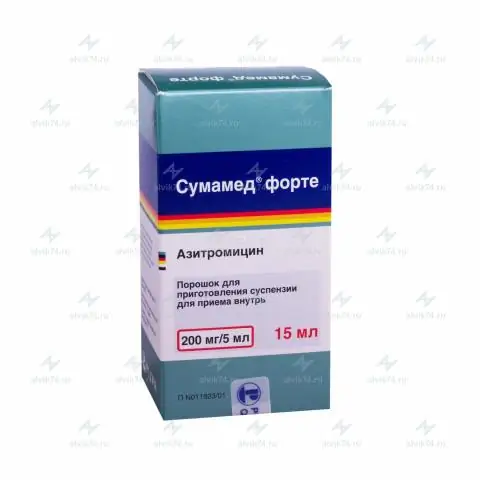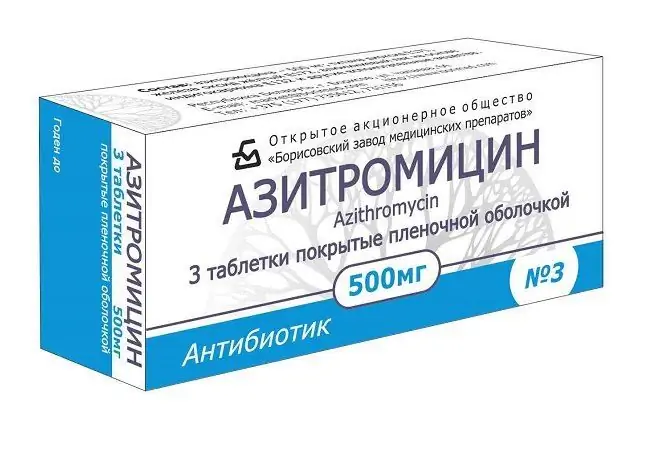- Author Rachel Wainwright [email protected].
- Public 2023-12-15 07:39.
- Last modified 2025-11-02 20:14.
Azithromycin Forte-OBL
Azithromycin Forte-OBL: instructions for use and reviews
- 1. Release form and composition
- 2. Pharmacological properties
- 3. Indications for use
- 4. Contraindications
- 5. Method of application and dosage
- 6. Side effects
- 7. Overdose
- 8. Special instructions
- 9. Application during pregnancy and lactation
- 10. Use in childhood
- 11. In case of impaired renal function
- 12. For violations of liver function
- 13. Drug interactions
- 14. Analogs
- 15. Terms and conditions of storage
- 16. Terms of dispensing from pharmacies
- 17. Reviews
- 18. Price in pharmacies
Latin name: Azithromycin Forte-OBL
ATX code: J01FA10
Active ingredient: azithromycin (Azithromycin)
Manufacturer: JSC "FP" Obolenskoye "(Russia)
Description and photo update: 2019-10-07
Prices in pharmacies: from 53 rubles.
Buy

Azithromycin Forte-OBL is a broad-spectrum macrolide antibacterial drug.
Release form and composition
Dosage form - film-coated tablets: scored, oblong biconvex, shell color - light blue, cores in cross-section - almost white or white (in a cardboard box there are 1-6 blisters of 2, 3 or 6 tablets and instructions for the use of Azithromycin Forte-OBL).
Composition of 1 tablet:
- active substance: azithromycin - 500 mg (in the form of azithromycin dihydrate - 524.11 mg);
- additional components: crospovidone, hydroxypropyl cellulose (hyprolose), magnesium stearate, microcrystalline cellulose, sodium lauryl sulfate;
- film casing: Opadry II (85 series): titanium dioxide, yellow iron oxide, aluminum varnish based on indigo carmine dye, polyvinyl alcohol, polyethylene glycol (macrogol), talc.
Pharmacological properties
Pharmacodynamics
Azithromycin Forte-OBL is a broad-spectrum macrolide antibiotic, azalide, has bacteriostatic properties. It binds to the 50S subunit of the ribosome, thereby inhibiting protein synthesis, slowing down the growth and reproduction of bacteria. In the case of high doses, it has a bactericidal effect.
Acts on intra- and extracellular pathogens. Shows activity against the following microorganisms:
- aerobic gram-positive and gram-negative microorganisms: Streptococcus pneumonia (penicillin susceptible), Staphylococcus aureus (methicillin susceptible), Streptococcus pyogenes, Haemophilus parainfluenza, Haemophilus influenzae, Passeria gonorrhoeila, Neisseria gonorrhoeila;
- some anaerobic microorganisms: Prevotella spp., Fusobacterium spp., Clostridium perfringens, Porphyromonas spp.;
- other pathogens: Borrelia burgdorferi, Mycoplasma hominis, Chlamydia trachomatis, Chlamydia psittaci, Chlamydia pneumoniae, Mycoplasma pneumoniae.
Insensitive or moderately sensitive to the action of the drug, aerobic gram-positive microorganisms - Streptococcus pneumonia (moderately sensitive or resistant to penicillin).
Azithromycin Forte-OBL is not active against the following microorganisms:
- aerobic gram-positive microorganisms: Enterococcus faecalis, Staphylococcus spp. (methicillin resistant);
- anaerobes of the Bacteroides fragilis group.
Beta-hemolytic Streptococcus spp. group A, Streptococcus pneumonia, Enterococcus faecalis and Staphylococcus aureus (including methicillin-resistant strains), which are resistant to erythromycin and other macrolides and lincosamides, also show resistance to azithromycin.
Pharmacokinetics
Azithromycin is rapidly absorbed from the gastrointestinal tract, this is due to the stability of the substance in an acidic environment and lipophilicity. After ingestion, it is rapidly distributed throughout the body, while high concentrations of the antibiotic are observed in the tissues. The time to reach C max (maximum concentration of the substance) after oral administration at a dose of 500 mg is from 2.5 to 2.9 hours, C max is 0.4 mg / l, bioavailability is 37.5%.
Azithromycin is characterized by good penetration into the respiratory tract, tissues and organs of the urogenital tract (including the prostate gland), soft tissues and skin.
The substance binds to blood plasma proteins at a low level, is able to penetrate into eukaryotic cells and concentrate in an environment with a low pH that surrounds lysosomes. This provides a high tissue concentration (10-50 times higher than plasma concentration) and a long T 1/2 (half-life). It also causes a large apparent V d (volume of distribution), namely 31.1 l / kg, and a high plasma clearance. For the elimination of intracellular pathogens, the ability of azithromycin to accumulate mainly in lysosomes is especially important.
It has been reliably established that phagocytes deliver azithromycin to the sites of infection, after which it is released during phagocytosis. In the foci of infection, the concentration of azithromycin is significantly higher than in healthy tissues (the average excess is 24-34%), this value correlates with the degree of inflammatory edema.
After taking the last dose, the substance remains in bactericidal concentrations for 5-7 days. As a result, short courses of treatment (3 and 5 days) have been developed.
The demethylation process occurs in the liver, the metabolites formed during this process do not show activity.
Azithromycin is excreted from blood plasma in two stages (depending on the interval that has passed after administration): in the interval of 8-24 hours T 1/2 is 14-20 hours, in the interval of 24-72 hours - 41 hours. Thanks to this, Azithromycin Forte-OBL can be taken once a day.
Excretion of azithromycin occurs mainly with bile in the form of an unchanged substance, a small part of the dose is excreted by the kidneys.
Indications for use
Azithromycin Forte-OBL is intended for the treatment of diseases of an infectious and inflammatory nature, which are caused by microorganisms sensitive to the action of the drug:
- infections of the ENT organs and upper respiratory tract, including otitis media, tonsillitis, sinusitis, pharyngitis;
- bacterial infections of the lower respiratory tract, including those caused by atypical pathogens, exacerbation of chronic bronchitis, pneumonia;
- infections of soft tissues and skin, including impetigo, erysipelas, secondarily infected dermatoses;
- urinary tract infections, including cervicitis, non-gonorrheal and gonorrheal urethritis;
- borreliosis (Lyme disease) - use in the initial stages with erythema migrans.
Contraindications
Absolute:
- severe renal and / or hepatic impairment;
- combined use with dihydroergotamine and ergotamine;
- lactation period;
- age up to 12 years with a body weight of less than 45 kg;
- hypersensitivity to the components of the drug, as well as to other macrolides.
Relative (the use of Azithromycin Forte-OBL should be carried out under medical supervision):
- dysfunction of the liver or kidneys in a moderate course;
- arrhythmia;
- combined use with terfenadine, warfarin, digoxin;
- pregnancy.
Azithromycin Forte-OBL, instructions for use: method and dosage
Azithromycin Forte-OBL is intended for oral administration. The recommended meal interval is 1 hour before or 2 hours after. Frequency rate of application - 1 time per day.
In the treatment of infections of the respiratory tract, ENT organs, soft tissues and skin, Azithromycin Forte-OBL is prescribed in a daily dose of 500 mg for a course of three days.
For uncomplicated urethritis or cervicitis (urinary tract infections), a single dose of 1000 mg is indicated.
In the treatment of stage I of Lyme disease (Erythema migrans), 1000 mg is used on the first day, then 500 mg each for 4 days.
Side effects
Taking Azithromycin Forte-OBL may be accompanied by the development of the following adverse reactions (> 10% - very often;> 1% and 0.1% and 0.01% and <0.1% - rarely; <0.01% - very rarely):
- nervous system: infrequently - convulsions, headache, vertigo, drowsiness, dizziness, perversion of smell and taste; rarely - hyperactivity, anxiety, anxiety, nervousness, insomnia, paresthesia, asthenia, aggressiveness;
- digestive system: often - nausea, diarrhea, vomiting, cramps or abdominal pain; infrequently - anorexia, loose stools, flatulence, indigestion; rarely - hepatitis, discoloration of the tongue, constipation, pseudomembranous colitis, cholestatic jaundice, impaired liver function tests (increased activity of hepatic transaminases), liver failure and liver necrosis (possibly fatal);
- genitourinary system: infrequently - vaginitis; rarely - acute renal failure, interstitial nephritis;
- musculoskeletal system: infrequently - arthralgia;
- heart and blood vessels: rarely - palpitations, arrhythmia (including ventricular and pirouette tachycardia), lengthening of the QT interval;
- skin: rarely - erythema multiforme, photosensitivity, toxic epidermal necrolysis;
- hematopoietic organs: rarely - thrombocytopenia; very rarely - transient neutropenia;
- sense organs: rarely - ringing in the ears, hearing impairment, deafness;
- allergic reactions: infrequently - urticaria, rash, itching of the skin; rarely - anaphylactic reactions, angioedema, Stevens-Johnson syndrome;
- others: rarely - candidiasis.
Overdose
The main symptoms of an overdose of Azithromycin Forte-OBL are deafness, nausea, diarrhea, and vomiting.
Therapy: gastric lavage, intake of activated charcoal, symptomatic treatment.
special instructions
Azithromycin Forte-OBL should not be taken with food.
If a dose is missed, it should be taken as early as possible and the next dose should be taken 24 hours later.
If it is necessary to use it simultaneously with antacids, the break should be at least two hours.
Hypersensitivity reactions after discontinuation of therapy in some cases may persist, and specific treatment is required under medical supervision.
For Streptococcus pyogenes pharyngitis and tonsillitis, penicillins are the antibacterial drugs of choice. The effectiveness of the use of Azithromycin Forte-OBL for the prevention of rheumatic fever has not been established.
Against the background of the use of azithromycin, as in the case of therapy with other antibiotics, superinfection (including fungal) may develop.
Influence on the ability to drive vehicles and complex mechanisms
During the period of taking Azithromycin Forte-OBL, you should refrain from driving.
Application during pregnancy and lactation
- pregnancy: therapy with Azithromycin Forte-OBL is possible only in cases where the expected benefit is higher than the potential harm;
- period of breastfeeding: the use of the drug is contraindicated.
Pediatric use
It is contraindicated to prescribe Azithromycin Forte-OBL to patients under 12 years of age with a body weight of less than 45 kg.
With impaired renal function
- severe renal failure: taking Azithromycin Forte-OBL is contraindicated;
- moderate renal dysfunction: therapy should be carried out under medical supervision.
For violations of liver function
- severe liver failure: taking Azithromycin Forte-OBL is contraindicated;
- liver dysfunction in a moderate course: therapy should be carried out under medical supervision.
Drug interactions
- cycloserine, indirect anticoagulants, methylprednisolone, felodipine, drugs that undergo microsomal oxidation (including hexobarbital, carbamazepine, cyclosporine, phenytoin, terfenadine, ergot alkaloids, valproic acid, bromocriptine, peroxidase, and hyporamine); their elimination and increase in plasma concentration and toxicity;
- antacids (containing aluminum and magnesium), food and ethanol: when used together, the absorption of azithromycin slows down and decreases, so it must be taken 1 hour before or 2 hours after taking them;
- cyclosporine: if necessary, simultaneous use, it is necessary to monitor the concentration of cyclosporine in the blood and adjust its dose;
- warfarin: the likelihood of an increase in the anticoagulant effect must be taken into account, careful monitoring of prothrombin time and INR (international normalized ratio) is required;
- digoxin: combined use leads to an increase in its concentration;
- ergotamine and dihydroergotamine: there is an increase in toxic effects, therefore, the simultaneous use of these drugs with azithromycin is contraindicated;
- triazolam: with combined therapy, its clearance decreases and the pharmacological effect increases;
- tetracycline and chloramphenicol: the effect of azithromycin therapy is enhanced;
- lincosamines: the effect of azithromycin therapy is weakened;
- rifabutin: against the background of combined use, the development of neutropenia is possible.
Analogs
Analogues of Azithromycin Forte-OBL are: Azitral, Azibiot, Azidrop, Hemomycin, Azivok, Azithromycin, Azithromycin Sanofi, Azitrox, AzitRus, Vero-Azithromycin, Zitrolide, Zitnob, Zitrocin, Ziromin, Sumazidamax retardli, Sumidli 1000 Tremak-Sanovel, Sumamed, Ecomed, etc.
Terms and conditions of storage
Store at temperatures up to 25 ° C in a place protected from moisture and light. Keep out of the reach of children.
The shelf life is 3 years.
Terms of dispensing from pharmacies
Dispensed by prescription.
Reviews about Azithromycin Forte-OBL
Most reviews of Azithromycin Forte-OBL are positive. Most often, the advantages of the drug include low cost and convenient dosing regimen. There are reports of the development of adverse reactions, sometimes of a pronounced nature.
Price for Azithromycin Forte-OBL in pharmacies
The approximate price for Azithromycin Forte-OBL (3 tablets in a package) is 198 rubles.
Azithromycin Forte-OBL: prices in online pharmacies
|
Drug name Price Pharmacy |
|
Azithromycin Forte-OBL 500 mg film-coated tablets 3 pcs. RUB 53 Buy |

Maria Kulkes Medical journalist About the author
Education: First Moscow State Medical University named after I. M. Sechenov, specialty "General Medicine".
Information about the drug is generalized, provided for informational purposes only and does not replace the official instructions. Self-medication is hazardous to health!






